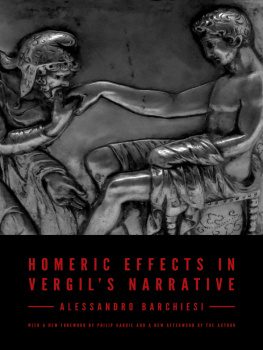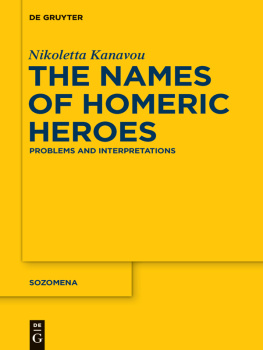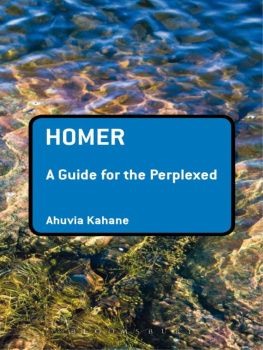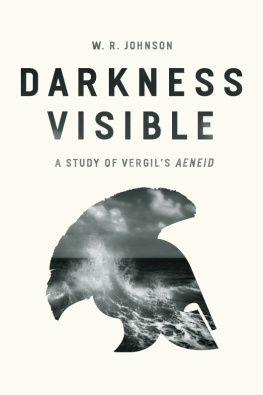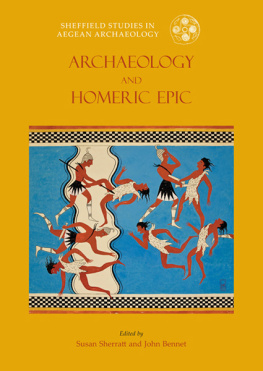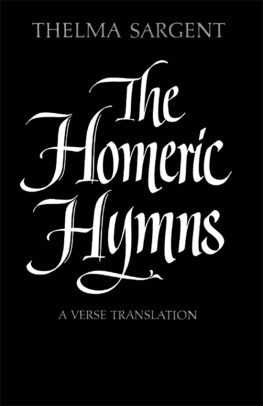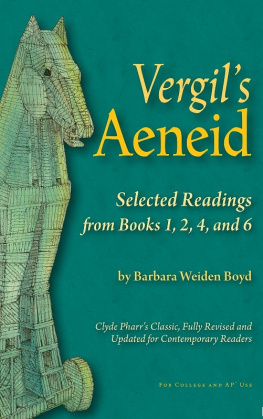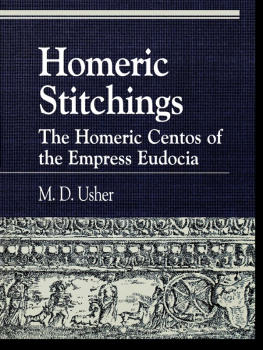
HOMERIC EFFECTS IN VERGILS NARRATIVE
HOMERIC EFFECTS IN VERGILS NARRATIVE
ALESSANDRO BARCHIESI
TRANSLATED BY
ILARIA MARCHESI & MATT FOX
WITH A NEW FOREWORD BY
PHILIP HARDIE
and a new afterword by the author
PRINCETON UNIVERSITY PRESS
Princeton & Oxford
Copyright 2015 by Princeton University Press
Published by Princeton University Press
41 William Street, Princeton, New Jersey 08540
In the United Kingdom: Princeton University Press
6 Oxford Street, Woodstock, Oxfordshire OX20 1TW
Originally published in Italian as La traccia del modello
1984 by Giardini editori e stampatori in Pisa
press.princeton.edu
Jacket photograph: detail of a silver cup from Hobys Tomb
Jens Vermeersch. Cropped from original.
Licensed under Creative Commons 2.0 license
(https://creativecommons.org/licenses/by-nc-nd/2.0/)
All Rights Reserved
Library of Congress Cataloging-in-Publication Data
Barchiesi, Alessandro, author.
[Traccia del modello. English]
Homeric effects in Vergils narrative / Alessandro Barchiesi ; translated by Ilaria Marchesi and Matt Fox with a new foreword by Philip Hardie and a new afterword by the author.
pages cm
Includes bibliographical references and index.
ISBN 978-0-691-16181-5 (hardcover)
1. Virgil. Aeneis. 2. Epic poetry, LatinHistory and criticism. 3. Narration (Rhetoric)HistoryTo 1500. 4. Latin poetryGreek influences. 5. HomerAppreciationRome. 6. Imitation in literature. 7. RomeIn literature. 8. HomerInfluence. 9. Rhetoric, Ancient.
PA6931.B3413 2015
873.01dc23
2014012449
British Library Cataloging-in-Publication Data is available
This book has been composed in Garamond Premier Pro and League Gothic
Printed on acid-free paper.
Printed in the United States of America
1 3 5 7 9 10 8 6 4 2
CONTENTS
FOREWORD
BY PHILIP HARDIE
THE DEATH OF PALLAS
Intertextuality and Transformation of the Epic Model
THE STRUCTURE OF AENEID 10
THE ARMS IN THE SKY
Diffraction of a Narrative Theme
THE DEATH OF TURNUS
Genre Model and Example Model
APPENDIX
THE LAMENT OF JUTURNA
AFTERWORD
BY ALESSANDRO BARCHIESI
FOREWORD
Alessandro Barchiesi began La traccia del modello. Effetti omerici nella narrazione virgiliana by noting that twenty years had passed since the publication of Georg Knauers monumental study of Vergils use of Homer in the Aeneid, Die Aeneis und Homer. Studien zur poetischen Technik Vergils (1964), a revision of Knauers 1961 Habilitationsschrift. It is now (2014) thirty years since the Italian publication of Homeric Effects in Virgils Narrative. It is astonishing to think that La traccia was based substantially on its authors honors thesis, the work of a brilliant scholar in his early twenties.
Knauers book, building on centuries of Vergilian commentary and drawing on the riches of German Vergilian scholarship of the previous seventy years, was the first full and integrated study both of the complex architecture of Vergils imitation of Homer and of the filigree detail of Vergils allusion to particular episodes, lines, and phrases of the Homeric epics. Fifty years on, Die Aeneis und Homer remains the starting point for any study of Vergil and Homer. La traccia was the product of a watershed in the history of Latin literary studies in the 1970s and early 1980s, a period that has largely determined the way Latinists have been doing things down to the present day. The young Barchiesi was at the very forefront of this nouvelle vague; the book is already completely at home with a number of terms that have defined major approaches to the study of ancient literature over the last three decades but that in the early 1980s were only beginning to make their way into the consciousness of Anglophone Latinists: narratology, intertextuality, reception. The book also makes a significant contribution to another highly productive area of Latin studies, the dialogue of genres, or generic polyphony, with its perceptive analyses of Vergils refraction of Homeric epic models through the lens of the outlooks and structures of Attic tragedy.
Barchiesis early intellectual formation was in continental and Russian literary theory, but the major achievement of La traccia is to be located in the area of what has been perhaps the most influential Italian contribution to modern Latin literary scholarship, the study of allusion and intertextuality. Prior to La traccia the major landmarks are Giorgio Pasqualis 1951 essay Larte allusiva, and the essays by one of Barchiesis own teachers at Pisa, Gian Biagio Conte, collected in Memoria dei poeti e sistema letterario: Catullo, Virgilio, Ovidio, a book published in 1974 but whose full impact outside Italy had to await its English translation as the first part of G. B. Conte, The Rhetoric of Imitation: Genre and Poetic Memory in Virgil and Other Latin Poets (1986).
La traccia advances the discussion in a number of ways. The Italian title puns in a manner not easily conveyed in English. Traccia can mean trace, trail, or track, holding together two ways of thinking about the relationship between a model text (in this case, the Homeric epics) and an alluding text (the Aeneid): a reader may either focus on fragmentary traces of the model text subsumed within the structures of the alluding text or look for systematic Homeric trails inscribed in the Vergilian text.use of the schemata of situational genres as a starting point for reading ancient poetry, in his Generic Composition in Greek and Roman Poetry (1972), to name an important work in the Anglophone tradition that was developing independently of continental work in the late 1960s and early 1970s.
Barchiesi develops his approach through sustained and multilayered readings of a limited number of passages in books 8, 10, and 12 of the Aeneid, together with a revelatory quasi-structuralist analysis of the whole sequence of encounters on the battlefield in Aeneid 10. In the several chapters he deploys the full armory of philological and literary-historical weaponry in the service of a powerful intertextual method. Not the least important service rendered by the book is the demonstration of the inseparability of, on the one hand, formalist readings, and, on the other, cultural-historical and ideological readings (for programmatic statements of principle on the need to combine the formalist and the historical, see ). Together with Gian Biagio Conte, the second of Barchiesis thesis supervisors was Antonio La Penna, the leading Italian Latinist in a marxisant tradition of historical and political readings of poetry. In this respect the book achieves an unusually satisfying coincidentia oppositorum, steering a course between the Scylla of an inward-looking formalism that is the fate of some intertextual and generic studies and the Charybdis of an exclusive set toward the culturalism or ideology critique against which Charles Martindale (2005) has taken up cudgels.
La traccia generates complex, but never confusing, readings of the Aeneid through two strategies: first the demonstration of the presence within a single Vergilian episode of separate narrative strands in the Homeric text (akin to what Knauer labels Kontaminierung, and to what I have labeled combinatorial imitation, with reference to post-Vergilian epic imitations of the
Next page
